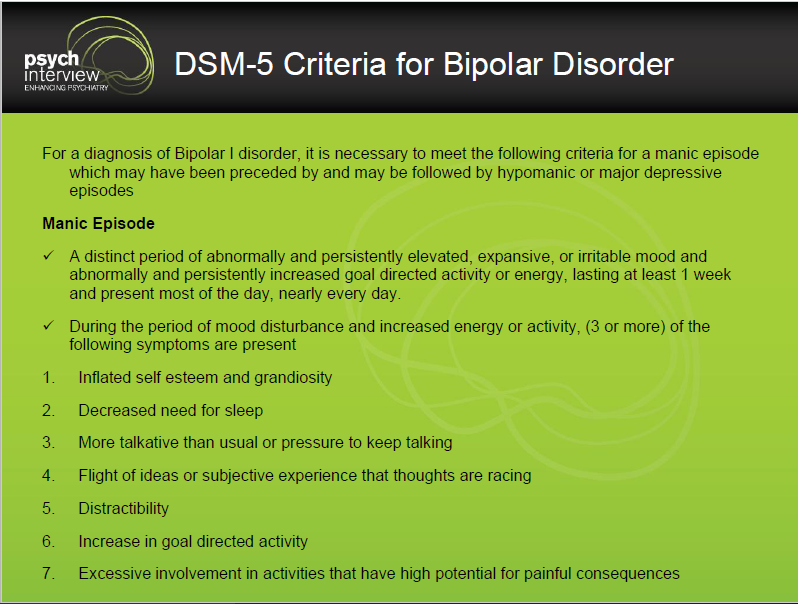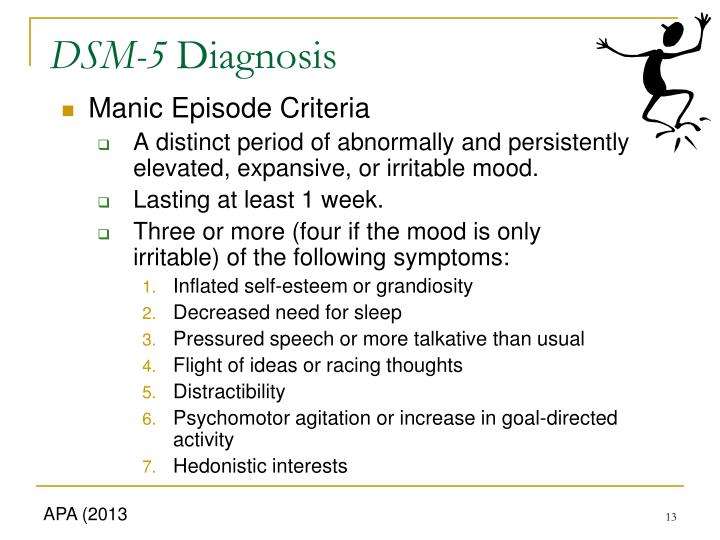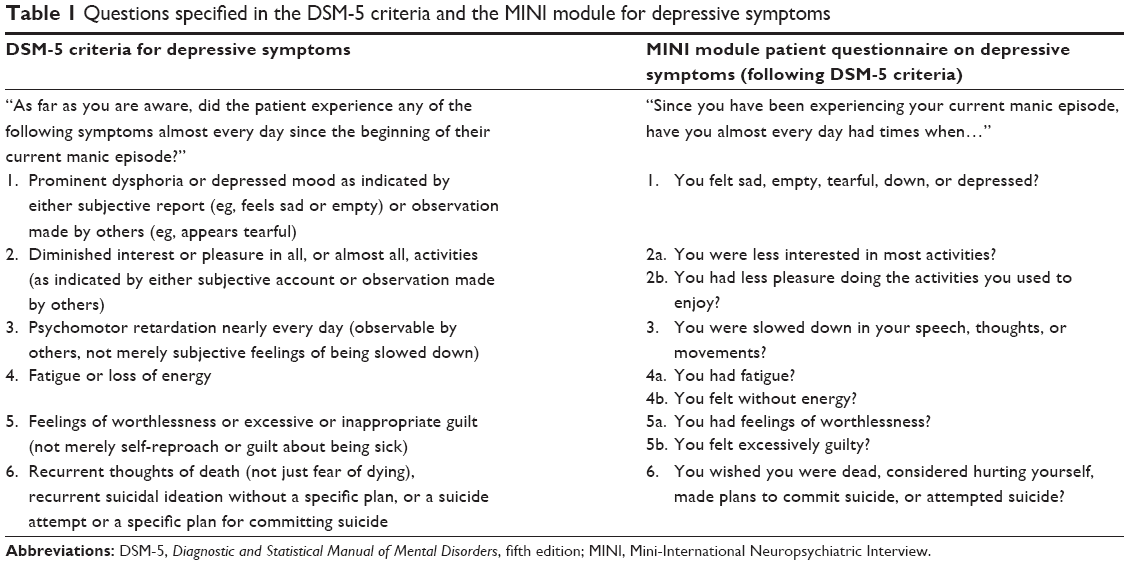Gate Questions For Mania And Hypomania
Where DSM-IV required, as criterion A, the presence of one of the two mood symptoms , in DSM-5, the mood change must be accompanied by persistently increased activity or energy levels. This new rule is, of course, more restrictive and excludes all individuals who report only one of the three entry symptoms and those with both elated and irritable mood. Thus, for no apparent reason, DSM-5 classifies some patients as having subthreshold bipolar disorders who would formerly have been diagnosed with manic episodes or bipolar I or II disorders. This strict new rule is not based on data, indeed it contradicts available evidence. As the international Bridge Study of 5,635 patients seeking treatment for major depressive episodes demonstrated clearly, any of those three gate questions is valid on its own, according to the criteria established by Robins and Guze and Angst et al. .
What Is Bipolar Disorder
Bipolar disorder is actually a group of mood disorders characterized by cyclical disturbances in mood, thoughts, and behavior. These disorders consist of alternating periods of elevated, expansive, or irritable moods, called manic episodes. They also include periods of feeling worthless, a lack of concentration, and fatigue called depressive episodes. The disorders differ in the severity of these two phases.
Can Bipolar Disorder Run In The Family
Yes, a family history of bipolar disorder is the most influential risk factor for bipolar disorder. If youre concerned about your mental health symptoms, make sure to ask grandparents or older family members if they remember anyone else in the family facing similar struggles.
Your doctor will ask about your familys history of mental health during your diagnosis.
Also Check: What Percentage Of The World Suffers From Depression
Bipolar Disorder In The Dsm
Even though childhood bipolar disorder has been well-defined and used for many years, pediatric bipolar disorder is not a new diagnosis in the DSM-5. Instead, a category of depressive disorders has been added called disruptive mood dysregulation disorder . The driver for this was a concern that the diagnosis of pediatric bipolar disorder was being inconsistently and overly applied to different types of childhood irritability.
For bipolar disorder under the DSM-5, there are now seven possible diagnoses:
- Bipolar I disorder
- Substance/medication-induced bipolar and related disorder
- Bipolar and related disorder due to another medical condition
- Other specified bipolar and related disorder
- Unspecified bipolar and related disorder
Additional changes include:
- Elimination of “mixed episode.” Instead, a manic, hypomanic, or depressive episode can be specified as “with mixed features,” a specifier with its own definition in the manual.
- The bipolar II diagnosis in the DSM-IV excluded a history of mixed episodes. This exclusion has been removed, which was an important change.
- A subtle change is that the word “abnormally” was not included in the DSM-IV criterion A for a hypomanic episode, while it was in criterion A for a manic episode. In the DSM-5, this language is present for both episodes. This brings the full criteria for the two distinct types of episodes closer together.
Each type of bipolar disorder has what are called specifiers that further clarify the illness.
Does Bipolar Disorder Look Different In Men Vs Women

Both men and women are affected equally and have similar symptoms. However, men usually experience mania first while women typically start with depressive episodes. Women and people with bipolar II disorder are significantly more likely to experience periods of rapid cycling than men with the same condition. Other research findings indicate that women with bipolar disorder may have more depressive episodes and more mixed episodes than do men with the illness.
Don’t Miss: Major Depressive Disorder Recurrent Moderate With Anxious Distress
What Are The Signs And Symptoms Of Bipolar Disorder
Before you self-diagnose, remember, were not talking about being down in the dumps over a breakup or having a bad day, or being super-happy over a promotion or a new relationship. These are natural highs and lows that everyone experiences. The classic symptoms of bipolar disorder are kind of like being on the steepest roller coaster, where moods dip from the lowest depression to the highest high .
Impact Of Bipolar 2 Disorder
People with an untreated bipolar disorder may have serious problems in many features of their lives. The various depressive, hypomanic, or manic episodes may seriously impair functioning. The average age of onset is mid-20s, which is later than type 1 bipolar but earlier than major depressive disorder . People with untreated bipolar 2 may have a lower socioeconomic status due to a lag in occupational recovery after episodes. But early intervention for the disorder can help prevent negative functional consequences.
Don’t Miss: Baclofen For Anxiety And Depression
What Are Bipolar Disorders
Bipolar disorder is a brain disorder that causes changes in a person’s mood, energy, and ability to function. People with bipolar disorder experience intense emotional states that typically occur during distinct periods of days to weeks, called mood episodes. These mood episodes are categorized as manic/hypomanic or depressive . People with bipolar disorder generally have periods of neutral mood as well. When treated, people with bipolar disorder can lead full and productive lives.
People without bipolar disorder experience mood fluctuations as well. However, these mood changes typically last hours rather than days. Also, these changes are not usually accompanied by the extreme degree of behavior change or difficulty with daily routines and social interactions that people with bipolar disorder demonstrate during mood episodes. Bipolar disorder can disrupt a persons relationships with loved ones and cause difficulty in working or going to school.
Bipolar disorder is a category that includes three different diagnoses: bipolar I, bipolar II, and cyclothymic disorder.
People with bipolar I disorder frequently have other mental disorders such as anxiety disorders, substance use disorders, and/or attention-deficit/hyperactivity disorder . The risk of suicide is significantly higher among people with bipolar I disorder than among the general population.
Bipolar Disorder Vs Major Depression
You may have heard of people who were first diagnosed with depression but later diagnosed with bipolar disorder, and this can be confusing. How can you tell the difference? Keep in mind that the hallmark of bipolar disorder is the presence of episodes of mania or hypomania. These are not present in major depression.
Another common question that’s asked is “Can depression turn into bipolar disorder?” The answer to that question is no, depression doesn’t transition into bipolar disorder later on.
However, it is possible for someone to be diagnosed while they are in the depressive phase, which may result in a diagnosis of depression. At the time, they may not recall or be asked about symptoms of mania or hypomania that would lead to a bipolar diagnosis. Later on, with more careful questioning, or with the occurrence of a manic or hypomanic episode, the diagnosis of bipolar may become clear.
You May Like: How To Beat Depression Fatigue
Can You Get A Bipolar Disorder Diagnosis Removed Or Reversed
A diagnosis for bipolar disorder usually is not removed because its a lifelong disorder.
But if you feel that your condition has been misdiagnosed, do not hesitate to advocate for yourself and seek a second medical opinion. Additional healthcare professionals may be able to reverse or amend a misdiagnosis of bipolar disorder.
Who Is A Candidate For Diagnosis
Mood episodes are the main characteristic of bipolar disorder, and everyone experiences these a little differently. Most people who live with bipolar disorder experience manic episodes and depressive episodes .
These episodes can last for several days, weeks, or more. People with bipolar disorder tend to fluctuate rapidly between mania and depression. Some people with bipolar disorder have long periods of time with neutral moods as well.The way people experience manic episodes varies from one person to another, but the episodes are
Recommended Reading: How Does Depression Work In The Brain
Future Directions In Research On The Bipolar Spectrum
As I see it, future research should focus on the independence of mania and hypomania from bipolar disorder, and the unsolved issue in adolescent psychiatry of whether hyperthymic behaviour in some adolescents remains within the normal range of variation of emotional development or emotional dysregulation . This developmental phase is strongly associated with the start of substance misuse , which may be secondary to normal adolescent highs or to early hypomanic episodes, as suggested by the results of the NCS-A study . Adolescents therefore pose a special difficulty – that of distinguishing between developmental trait/temperament and states . The traditional criteria for caseness, such as distress or impairment, are not applicable to typical syndromes of hypomania and mania since the subjects do not feel in any way ill or impaired. In most cases, the only conclusive basis for diagnosing undesired social consequences may be the information provided by parents, friends, teachers or employers.
Another topic requiring further research is the duration criteria for MDE and for hypomania , the validity if which has been questioned by recent data from the Bridge and the Zurich studies . In principle, all continuous variables, such as distress/suffering, impairment, episode duration and time spent in illness over 1 year , should be measured systematically in clinical assessments and not just dichotomized for diagnostic definitions.
Attenuated Psychosis Syndrome And Shared Psychotic Disorder

The Psychotic Disorders Work Group considered adding attenuated psychosis syndrome as a new diagnosis to DSM-5, but instead decided to place it in Section III as a condition for further study, after field trial data showed that it was not diagnosed reliably by clinicians. Attenuated psychosis syndrome is meant to describe people who show recent onset of modest, psychotic-like symptoms and clinically relevant distress and disability . In addition, the person who experiences the symptoms must recognize them as unusual and experience sufficient distress or disability to seek clinical evaluation. Despite the clear guidance in the DSM-5 that conditions in Section III are not intended for clinical use, this syndrome is not just in Section III, but is also specifically identified in Other Specified Schizophrenic Spectrum and Other Psychotic Disorder as one of four examples of alternative presentations of a psychotic disorder where it is labeled other psychotic disorder, attenuated psychosis syndrome .
Don’t Miss: Clinical Depression In Young Adults
Whats A Person With Bipolar Like
When someone is managing their bipolar disorder well, they likely wont appear any different from anyone else. If theyre in a manic episode you might notice they talk fast, switch topics continually, have grandiose plans or ideas, or take risks. When in a depressed episode they may have trouble getting out of bed, show a lack of interest in activities they used to love, not engage in conversation, have difficulty socializing or interacting with others, or have suicidal thoughts.
Specifiers For Mood Disorders
DSM-5 includes multiple specifiers to describe the Bipolar and Depressive Disorders , as part of a mixed categorical-dimensional approach. The specifiers are meant to define a more homogeneous subgrouping of individuals with the disorder who share certain characteristics and to convey information that is relevant to the management of the individual’s disorder . The presence of new and more detailed descriptive specifiers for the bipolar and depressive disorders may have some impact on forensic psychiatry. The specifiers are intended to be used to describe the course of a person’s disorder and should not affect the frequency of the underlying diagnosis, but some specifiers may have implications for suicide risk. In addition, these specifiers may be useful in forensic contexts where a prediction of future course may be helpful, such as sentencing, civil commitment, and child custody.
The specifier with seasonal pattern now includes all mood episodes in the introduction and the criteria, instead of being limited, as in DSM-IV, only to episodes of depression. However, the explanatory note makes it clear that the essential feature is the onset and remission of major depressive episodes at characteristic times of the year , which retains the intent of the DSM-IV criteria.
Also Check: Best Emotional Support Animals For Anxiety And Depression
Whats Going On In The Brain
Up until recently, researchers hadnt been able to distinguish a person with bipolars brain from a person without the disorder on a scan. But science is making some tracks. A 2019 study that looked at the brains of people with bipolar and those with depression on functional MRI scans correctly differentiated their brains about 80% of the time.
The findings suggest differences in the amygdala, the emotion center of the brain, of people with bipolar when they process emotions like sadness, anger, fear, and joy, and could become a marker to help identify bipolar disorder on brain scans. Likewise, bipolar affects brain biochemistry and neurotransmitters in the brain that produce chemical variations such as oxytocin, GABA, dopamine, and serotonin. These chemicals may be unbalanced in the brains of people with bipolar disorders. But as of yet, researchers arent clear on how too little GABA or too many oxytocin-active neurons play a role in the disorder or whether measuring them can help.
How Is Bipolar Disorder Treated
Treatment for bipolar disorder may include the use of mood stabilizers such as lithium. Certain anticonvulsants, antipsychotics, and benzodiazepines may also be used to stabilize mood. Sometimes antidepressants are given in combination with mood stabilizers to boost the depressed mood, although antidepressants are often not as effective as some mood stabilizers or certain atypical antipsychotics for treating depression in bipolar disorder.
Show Sources
Also Check: Symptoms Of Stress And Depression
Other Bipolar Disorder Treatment
Most patients respond very well to medication and various psychotherapies but there are some outliers who dont respond as well, points out Dr. Narasimhan. In this case, you may want to explore other options.
Transcranial Magnetic Stimulation
Medication-resistant patients can benefit from other treatments such as Transcranial magnetic stimulation . This non-invasive treatment works by using magnetic fields to stimulate nerve cells in the brain and improve depressive symptoms. The treatment delivers repetitive magnetic pulses via an electromagnetic coil placed against your scalp. Though the mechanism for how it works isnt well understood, its thought to impact how the brain works, which in turn can alleviate depressive episodes. TMS is well tolerated, doesnt include much downtime, and has only some side effects such as headache, tingling, and lightheadedness. There are some rare side effects such as seizure and hearing loss.
Electroconvulsive Therapy
Lifestyle and Integrative Treatments
Recommendations For Trials With Antidepressants
Non-response to ADs in MDD is correlated with hidden bipolarity . Systematic screening for hypomanic symptoms during the selection of patients for controlled antidepressant trials would have several benefits. It would identify bipolarity in patients with major depressive episodes and increase the homogeneity of the samples, increase the responder rates and the power of placebo-controlled trials, and finally reduce the sample sizes required. Systematic measures of hypomanic symptoms by rating scales during the trials would help to identify the development of mixed states and switches into hypomania.
Also Check: How To Overcome Depression Biblically
Bipolar And Related Disorders
The importance of nature in neurodevelopmental and schizophrenia spectrum disorders is readily apparent. Neurodevelopmental disorders appear too early in life for nurture to have a major influence and the symptoms can be physical as well as behavioral. For example, Down syndrome children have distinct anatomical features making them easy to identify. Autistic children and schizophrenic adults are usually physically indistinguishable from their peers however their defining symptoms are extreme and easily identifiable. Individuals with these diagnoses appear to differ from normal individuals qualitatively rather than quantitatively. Although it has been proposed in the past , there is no evidence to suggest that faulty parenting is the cause of autism or schizophrenia. Rather, the evidence supports attributing these severe disorders to an underlying biological problem .
Figure 11.4 Bipolar disorder
Underdiagnosis Of Bipolar Disorders Hypomania And Mania

The underrecognition of bipolar disorder is sadly set to continue despite the advances of DSM-5 described above. The re-analyses of large epidemiological studies demonstrated that DSM major depressive disorder is clearly heterogenous and includes about 40% of hidden bipolars. Without systematic screening for hypomania in patients’ previous history, DSM-5 will have little appreciable impact on the detection of this hidden bipolarity. The vast majority of patients with MDE will continue to be diagnosed as having MDD.
In this context, DSM-5’s non-recognition of pure mania and hypomania as diagnostic entities remains problematic in view of the accumulating evidence. Both conditions are fairly common in adolescence . Moreover, the large, representative, epidemiological NCS-A study has demonstrated the frequent independence of mania and hypomania from depression . Most recently, the NIMH family study of patients with mood disorders has shown that mania is even genetically independent . Adolescents, unlike adults, more often meet the DSM-IV criteria for mania and hypomania without MDD than for bipolar disorders, but they are often unaware of their mood changes, whereas adults’ retrospective assessments are rich in false negatives, as Moffitt et al. have recently demonstrated in relation to major depressive episodes.
Recommended Reading: Lack Of Sleep Causes Depression
At What Age Is Bipolar Disorder Usually Diagnosed
Bipolar disorder usually appears between ages 15 and 24 and persists through a lifetime. It’s rare that newly diagnosed mania is seen in young children or in adults over age 65.
Severity of symptoms varies with individuals who have bipolar disorder. While some people have a few symptoms, others have many that impair their ability to work and live a normal life.
Marked by relapses and remissions, bipolar disorder has a high rate of recurrence if untreated. Patients with severe mania usually require hospitalization to keep them from risky behaviors. Those who are severely depressed also might need hospitalization to keep them from acting on suicidal thoughts or psychotic symptoms .
About 90% of individuals with bipolar I disorder, which is the more serious form, have at least one psychiatric hospitalization. Two out of three will have two or more hospitalizations in their lifetime.